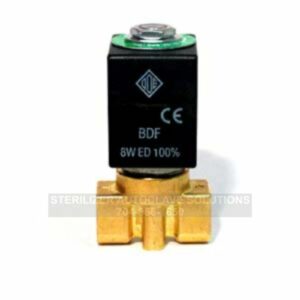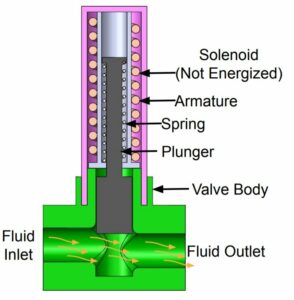The Autoclave Solenoid Valve
Information gathering on some subjects can be a bit more tedious than most. And when it comes to Medical technology it can sometimes be a hassle to research through basic means. For example, you may know how to safely and properly use an autoclave. But there may be some specific parts in the autoclave that you don’t know how they work and you want to know more.
basic means. For example, you may know how to safely and properly use an autoclave. But there may be some specific parts in the autoclave that you don’t know how they work and you want to know more.
Take for example: The autoclave solenoid valve, how does it work? When you do a basic web search for some things it can sometimes just turn up little, unsatisfying results. And if you just want fast information, it can be a drag to find. That is where we come in to help. Any information regarding medical tech or the sterilization industry that we have learned or newly find gets passed on to you. With that in mind this article is going to be about the solenoid valve. And if after this article you do have any more questions about the solenoid valve please give us a call. You can find us at 704-966-1650, option 3 for our Free Tech Support.
The Solenoid Valve is actually a very interesting piece of technology and is a very common part in industrial or even everyday machines. It’s not just autoclaves, but also air conditioners, wash machines, and most other things with fluids running through them to operate. So let’s jump in and learn more.
The Solenoid Valve
The solenoid valve is more common than you think. It’s used in so many things, things you might not even realize, so in this article, we’ll go over:
- How The Valve Works
- Why We Use Them
- The Types of Solenoid Valves There Are
How the Solenoid Valve Works
Solenoid Valves are valves that allow fluids to be remotely regulated. There are two pieces to this device, namely the solenoid and the valve. The diagram on the right lists the different parts and their positions. The valve is on the bottom. And the solenoid is housed in the device on top of the valve. The solenoid is a helical coil that spirals around the metal armature from the valve. And the coil passes electromagnetic signals from it to energize the spring to either open or close the plunger. The action that the spring performs, i.e. opening or closing, is based on what kind of solenoid valve you’re using. We’ll get to these two kinds of valves in a later section.
But this means it can be operated remotely and electronically, usually through a computer if anything. This, in turn (no pun intended), removes the need to be running around turning valves one by one.
There are many different shapes that solenoid valves can take, and the shape depends on these components:
- The type of pressure they’re dealing with
- The capacity of the valve
- The internal mechanisms
Why Do We Use Them?
Solenoid Valves allow us to manually or even remotely control the flow of a fluid through a system it’s connected to. Fluids can be either liquids or gas. Some of these fluids are:
- Water
- Air
- Gas
- Oil
- Steam
- Refrigerant
And there are more entries on this list as well. But depending on what you use the solenoid valve on, these are probably some of the most common fluids you’ll see.
What Are Some Types of Solenoid Valves?
There are a few different kinds of solenoid valve. But when talking about autoclaves we really only need to focus on two types. Direct-Acting valves are the most common. Like the one we mentioned before, just using a coil and its electromagnetic field to activate. In these types, there are two variations, a Normally Open (NO) and Normally Closed (NC).
Normally Closed
Both types of valves have an armature protruding from the body of the valve. That armature houses the spring and plunger mechanism. (See diagram graphic in “How the Solenoid Valve Works section.) The solenoid wraps this armature with coil, and generates an electromagnetic field around it. With Normally Closed valves, the spring is constantly pushing on the plunger to close the valve. It’s designed to sit closed indefinitely, hence “normally closed.” On Normally Closed Valves, when the electromagnetic signal is activated, the energy forces the plunger upward against the spring. This opens the valve’s path and allowing fluid to pass through. But once the coil isn’t energized, the spring forces the plunger back down, closing the valve.
Normally Open
Normally Open valves are almost exactly similar to the Normally Closed valves. The difference lies in their operations, as they’re essentially reversed. Normally Open valves have the same spring and plunger mechanism as Normally Closed. But Normally Open valves are, you guessed it, always open when no electromagnetic signal is present. So, once the electromagnetic current is activated, the spring instead forces the plunger down to close off the valve’s pathway. And once the coil isn’t energized, the plunger retains its original open position.
Final Thoughts
When it comes to information relevant to our field, we do our best to share it with you. Constantly building our online archive of the things we offer and how they work. And this article does just that. The autoclave Solenoid Valve is an important part of the autoclave, but it’s also important in general. So it should be known as to what it is and how it works. Some people might not know what a solenoid is or how it functions.
It allows for remote control over the flow of fluids in a machine that uses it. It solves the problem of worrying about one valve at a time wherever it’s placed and just lets you control them all remotely. It’s a remarkable piece of engineering technology that’s present in more common places than you may know or think. And if you have any questions about the autoclave solenoid valve or anything else, you can contact us using the links below.
As always if you have any questions about this process or anything else please feel free to contact us and take advantage of our “FREE TECH SUPPORT.”
We also offer FREE VIRTUAL TECH SUPPORT to “See and Talk” with a “Real Time Live Technician” for any problems you may be in need of help with.
You can also use our “FREE MAINTENANCE PROGRAM”. Take the guesswork and worrying about what unit is due for maintenance and which maintenance cycle it is time for. We will keep track of all your autoclaves and let you know when it’s time for anything.


